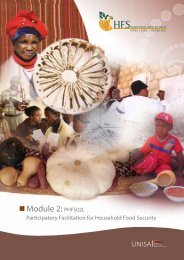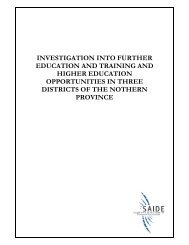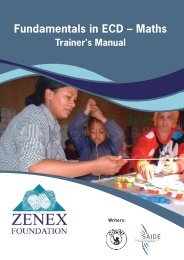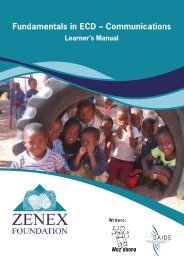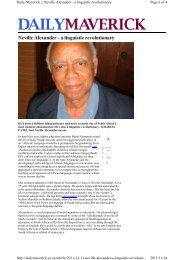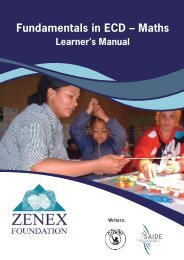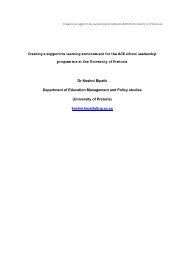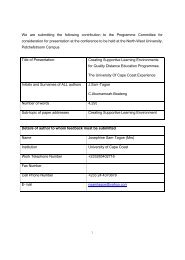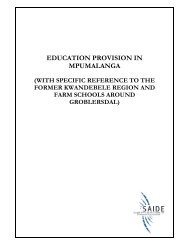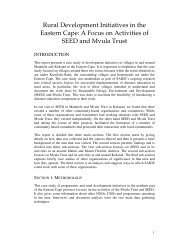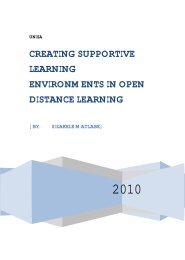Towards Sustainable Open and Distance Learning in the ...
Towards Sustainable Open and Distance Learning in the ...
Towards Sustainable Open and Distance Learning in the ...
You also want an ePaper? Increase the reach of your titles
YUMPU automatically turns print PDFs into web optimized ePapers that Google loves.
TOWARDS SUSTAINABLE OPEN AND DISTANCE LEARNING IN THE<br />
DEVELOPMENTAL STATE: FINANCING QUALITY DISTANCE<br />
EDUCATION<br />
PIERRE DU PLESSIS<br />
UNIVERSITY OF JOHANNESBURG<br />
Email: pierredp@uj.ac.za<br />
ABSTRACT<br />
<strong>Distance</strong> education represents a major component of higher education<br />
provision <strong>in</strong> South Africa. <strong>Distance</strong> learn<strong>in</strong>g is an excellent method of reach<strong>in</strong>g<br />
<strong>the</strong> adult students. Because of <strong>the</strong> compet<strong>in</strong>g priorities of work, home <strong>and</strong><br />
school adult students desire a high degree of flexibility. The structure of<br />
distance learn<strong>in</strong>g gives adults <strong>the</strong> greatest possible control over <strong>the</strong> time,<br />
place <strong>and</strong> pace of education.<br />
In 2001, 29% of all full-time equivalent students <strong>in</strong> public <strong>in</strong>stitutions, or 43%<br />
of all headcount students, were enrolled <strong>in</strong> declared distance programs. It<br />
shows that <strong>the</strong> use of distance education <strong>in</strong> higher education has significantly<br />
<strong>in</strong>creased access to higher education (CHE, 2003).<br />
The f<strong>in</strong>ancial logic of distance education, has <strong>in</strong> many ways been a response<br />
to education systems that are <strong>in</strong> crises because <strong>the</strong>y are push<strong>in</strong>g aga<strong>in</strong>st <strong>the</strong>ir<br />
speak<strong>in</strong>g academic’s ceil<strong>in</strong>g capacity to manage <strong>the</strong> learn<strong>in</strong>g of <strong>in</strong>com<strong>in</strong>g<br />
students.<br />
However, it has become a dangerous piece of conventional wisdom that<br />
distance learn<strong>in</strong>g is less expensive than traditional contact education. This<br />
paper wants to explore how quality education can be f<strong>in</strong>anced <strong>and</strong> what need<br />
to be done so that <strong>the</strong> quality of distance education is related to <strong>the</strong> level of<br />
<strong>in</strong>vestment <strong>in</strong> its design.<br />
Keywords: susta<strong>in</strong>able learn<strong>in</strong>g, distance learn<strong>in</strong>g, quality, economics,<br />
f<strong>in</strong>ances<br />
INTRODUCTION<br />
<strong>Distance</strong> education is becom<strong>in</strong>g more <strong>and</strong> more popular as economic forces<br />
encourage, <strong>and</strong> new technologies facilitate, its spread. There is a tremendous<br />
growth <strong>and</strong> diversity <strong>in</strong> distance learn<strong>in</strong>g, <strong>in</strong> <strong>the</strong> number <strong>and</strong> type of <strong>in</strong>dividuals<br />
learn<strong>in</strong>g outside traditional classrooms, <strong>in</strong> <strong>the</strong> variety of providers, <strong>in</strong> <strong>the</strong> range<br />
<strong>and</strong> effectiveness of new technologies serv<strong>in</strong>g as delivery tools for learn<strong>in</strong>g.<br />
1
The quality of open <strong>and</strong> distance learn<strong>in</strong>g (ODL) varies like any o<strong>the</strong>r form of<br />
education. Its quality can be <strong>the</strong> result of a variety of factors, both <strong>in</strong>ternal <strong>and</strong><br />
external to an open distance learn<strong>in</strong>g organization for example, <strong>the</strong> levels of<br />
skills <strong>and</strong> expertise of staff, <strong>the</strong> resources available, weak or strong leadership<br />
efficiency of its adm<strong>in</strong>istration systems, or <strong>the</strong> communication <strong>in</strong>frastructure <strong>in</strong><br />
a country.<br />
“<strong>Distance</strong> education is becom<strong>in</strong>g <strong>in</strong>creas<strong>in</strong>gly global, creat<strong>in</strong>g myriad new<br />
alliances as traditional educational <strong>in</strong>stitutions jo<strong>in</strong> with bus<strong>in</strong>ess, foreign<br />
governments <strong>and</strong> <strong>in</strong>ternational organizations to offer <strong>and</strong> use distance<br />
learn<strong>in</strong>g” (Sherry, 1996).<br />
<strong>Distance</strong> learn<strong>in</strong>g is used <strong>in</strong> a variety of sett<strong>in</strong>gs <strong>and</strong> for a broad range of<br />
purposes. Universities use it to <strong>in</strong>crease <strong>the</strong> number of students who have<br />
access to higher education, companies use it to upgrade <strong>the</strong> skills of <strong>the</strong>ir<br />
employees <strong>and</strong> to keep abreast of rapidly advanc<strong>in</strong>g technologies, <strong>in</strong>dividuals<br />
make use of distance learn<strong>in</strong>g for <strong>the</strong>ir own professional development <strong>and</strong> to<br />
enhance <strong>the</strong>ir career opportunities, governments use distance learn<strong>in</strong>g to<br />
provide on-<strong>the</strong>-job tra<strong>in</strong><strong>in</strong>g to teachers <strong>and</strong> o<strong>the</strong>r governmental workers, to<br />
enhance <strong>the</strong> quality of traditional primary <strong>and</strong> secondary school<strong>in</strong>g <strong>and</strong> to<br />
deliver <strong>in</strong>struction to very remote rural areas.<br />
Most <strong>in</strong>stitutions are concerned to achieve <strong>the</strong> highest possible quality, but not<br />
all have addressed <strong>the</strong> management of quality with<strong>in</strong> <strong>the</strong> organization <strong>in</strong> a<br />
systematic way as much as <strong>the</strong>y need to. Quality is often judged <strong>in</strong> terms of<br />
<strong>the</strong> learn<strong>in</strong>g materials, whatever <strong>the</strong> medium. These are <strong>the</strong> pivot on which<br />
<strong>the</strong> whole learn<strong>in</strong>g enterprise turns. However, a course is more than materials.<br />
Ideological arguments are made for open learn<strong>in</strong>g, economic ones for<br />
distance learn<strong>in</strong>g. If it can produce similar results to those of conventional<br />
education at a lower cost, <strong>the</strong>n distance education has a powerful appeal<br />
(Maguire, 2005).<br />
These are grounds for th<strong>in</strong>k<strong>in</strong>g that distance learn<strong>in</strong>g may have economic<br />
advantages. There are two sides to <strong>the</strong> argument. The educational side is <strong>the</strong><br />
<strong>the</strong>ory of media equivalence, that <strong>the</strong>re are no significant differences <strong>in</strong> <strong>the</strong><br />
effectiveness of different educational media. The economic side of distance<br />
learn<strong>in</strong>g allows a division of labour, <strong>in</strong> which a group of academics <strong>and</strong><br />
producers manufactures teach<strong>in</strong>g material, an organizational mach<strong>in</strong>e<br />
distributes it <strong>and</strong> ano<strong>the</strong>r group provides a m<strong>in</strong>imum of <strong>in</strong>dividual tutorial<br />
support to students.<br />
Economics of scale become possible provided that <strong>the</strong>re are enough students<br />
to justify <strong>the</strong> manufactur<strong>in</strong>g cost of <strong>the</strong> first group <strong>and</strong> student contact is kept<br />
down to conta<strong>in</strong> costs of <strong>the</strong> second.<br />
Various technologies have been used for distance learn<strong>in</strong>g, but pr<strong>in</strong>t-based<br />
correspondence courses have been <strong>and</strong> will cont<strong>in</strong>ue to be <strong>the</strong> dom<strong>in</strong>ant<br />
delivery mechanism <strong>in</strong> both <strong>the</strong> developed <strong>and</strong> <strong>the</strong> develop<strong>in</strong>g worlds.<br />
2
Pr<strong>in</strong>t is still <strong>the</strong> cheapest technology <strong>and</strong> even if <strong>the</strong> costs of us<strong>in</strong>g high-tech<br />
dissem<strong>in</strong>ation tools falls below those of pr<strong>in</strong>t, it will be some time before many<br />
countries have adequate <strong>in</strong>frastructures (Halse & Terzoli, 2002).<br />
DEFINITION AND CONTEXT OF DISTANCE LEARNING<br />
<strong>Distance</strong> learn<strong>in</strong>g is <strong>the</strong> process of transferr<strong>in</strong>g knowledge to students who<br />
are separated from <strong>the</strong> <strong>in</strong>structor (teacher) by time <strong>and</strong>/or physical distance<br />
<strong>and</strong> are mak<strong>in</strong>g use of technology components, such as <strong>the</strong> <strong>in</strong>ternet, video,<br />
DE’s, tapes <strong>and</strong> o<strong>the</strong>r forms of technology to accomplish learn<strong>in</strong>g (Campbell,<br />
2003).<br />
The California <strong>Distance</strong> <strong>Learn<strong>in</strong>g</strong> Project (CDLP) def<strong>in</strong>es distance learn<strong>in</strong>g as<br />
follows: “<strong>Distance</strong> learn<strong>in</strong>g (DL) is an <strong>in</strong>structional delivery system that<br />
connects students with educational resources. DL provider educational<br />
access to students not enroll<strong>in</strong>g <strong>in</strong> educational <strong>in</strong>stitutions <strong>and</strong> can augment<br />
<strong>the</strong> learn<strong>in</strong>g opportunities of current students. The implementation of DL is a<br />
process that uses available resources <strong>and</strong> will evolve to <strong>in</strong>corporate emerg<strong>in</strong>g<br />
technologies.” (http://www.cdlponl<strong>in</strong>e.org/<strong>in</strong>dex.cfm)<br />
<strong>Distance</strong> learn<strong>in</strong>g is what should occur if special consideration has been taken<br />
regard<strong>in</strong>g course design, <strong>in</strong>structional techniques, communication mediums,<br />
<strong>and</strong> organization <strong>and</strong> adm<strong>in</strong>istrative issues associated with <strong>the</strong> distance<br />
education program. Knowledge transfer should transpire despite “<strong>the</strong> fact that<br />
<strong>the</strong> <strong>in</strong>structor <strong>and</strong> student are geographically separated by time or distance”<br />
(Moore& Kearsley, 1996).<br />
<strong>Distance</strong> education is a systematic organized form of self study <strong>in</strong> which<br />
student counsel<strong>in</strong>g, <strong>the</strong> presentation of learn<strong>in</strong>g material <strong>and</strong> secur<strong>in</strong>g <strong>and</strong><br />
supervis<strong>in</strong>g of students’ success is carried out by a team of teachers, each of<br />
whom has responsibilities. It is made possible at a distance by means of<br />
media which can cover long distance.<br />
“<strong>Distance</strong> learn<strong>in</strong>g <strong>and</strong> distance education are terms used synonymously <strong>in</strong><br />
education <strong>and</strong> learn<strong>in</strong>g technologies. It is deemed that distance learn<strong>in</strong>g has<br />
been a method of teach<strong>in</strong>g <strong>and</strong> learn<strong>in</strong>g for many <strong>in</strong>dividuals for at least one<br />
hundred years,” accord<strong>in</strong>g to Moore & Kearsley, 1996).<br />
SIGNIFICANCE OF DISTANCE EDUCATION<br />
Educators of adults face <strong>the</strong> challenge of serv<strong>in</strong>g a student population <strong>and</strong><br />
society that is <strong>in</strong>creas<strong>in</strong>gly diverse. Mov<strong>in</strong>g <strong>in</strong>to <strong>the</strong> 21 st century, <strong>the</strong> adult<br />
population is expected to be <strong>the</strong> fastest grow<strong>in</strong>g segment of high education<br />
<strong>and</strong>, older students will constitute <strong>the</strong> majority.<br />
3
While distance education is already a fact of life for most universities <strong>and</strong> an<br />
<strong>in</strong>creas<strong>in</strong>g number of community colleges, know<strong>in</strong>g <strong>the</strong> “<strong>in</strong>tr<strong>in</strong>sic problems <strong>and</strong><br />
overcom<strong>in</strong>g <strong>the</strong>m will be critical to successful implementation of distance<br />
programs on a large scale <strong>in</strong> <strong>the</strong> future” (K<strong>in</strong>naman, 1995).<br />
In distance learn<strong>in</strong>g, students <strong>and</strong> teachers will f<strong>in</strong>d <strong>the</strong>mselves play<strong>in</strong>g<br />
different roles than is <strong>the</strong> norm <strong>in</strong> traditional education. The teacher is no<br />
longer <strong>the</strong> sole source of knowledge but <strong>in</strong>stead becomes a “facilitator to<br />
support student learn<strong>in</strong>g, while <strong>the</strong> student activity participates <strong>in</strong> what <strong>and</strong><br />
how knowledge is imparted” (Harry, 1992). <strong>Distance</strong> learn<strong>in</strong>g requires a<br />
collaborative effort between student <strong>and</strong> teacher, <strong>in</strong>bounded by <strong>the</strong> traditional<br />
limits of time, space <strong>and</strong> s<strong>in</strong>gle <strong>in</strong>structor effort.<br />
Technology has also changed <strong>the</strong> face of education. Advances <strong>in</strong><br />
telecommunications technology has opened up <strong>the</strong> possibility of personal <strong>and</strong><br />
group <strong>in</strong>teraction <strong>in</strong> distance education. Both computer <strong>and</strong> audio<br />
conferenc<strong>in</strong>g permit <strong>the</strong> <strong>in</strong>troduction of class discussions without <strong>the</strong> group<br />
meet<strong>in</strong>g face-to-face. Phone calls <strong>and</strong> electronic mail replaces personal office<br />
visits. The distance learner can now have almost <strong>the</strong> same <strong>in</strong>structional<br />
contact <strong>and</strong> <strong>in</strong>teraction as <strong>the</strong> student on campus. But remote access<br />
education does not need to elim<strong>in</strong>ate all <strong>the</strong> benefits of human contact. In fact,<br />
“<strong>the</strong> proliferation of <strong>the</strong> modern teleconferenc<strong>in</strong>g <strong>and</strong> <strong>the</strong> World Wide Web<br />
provides a rich expanse of both <strong>in</strong>formation <strong>and</strong> contacts that were previously<br />
unavailable” (Gulusha, 2004).<br />
FLEXIBILITY<br />
From a pedagogical po<strong>in</strong>t of view, distance education offers <strong>the</strong> students<br />
flexibility – flexibility of schedul<strong>in</strong>g <strong>the</strong> possibility of proceed<strong>in</strong>g at one’s own<br />
pace, <strong>the</strong> opportunity to study without hav<strong>in</strong>g to travel <strong>and</strong> <strong>in</strong> <strong>the</strong> best funded<br />
programmes, <strong>in</strong>dividualized attention from <strong>the</strong> lecturer (NADEOSA, 2005). At<br />
<strong>the</strong> same time, distance learn<strong>in</strong>g, when reduced to <strong>in</strong>dividualized self-study,<br />
can be isolat<strong>in</strong>g. Much of education consists of dialogue; <strong>the</strong> lack of a formal<br />
structure <strong>and</strong> timetable <strong>in</strong> distance learn<strong>in</strong>g can be detrimental to <strong>the</strong> tra<strong>in</strong><strong>in</strong>g<br />
experience <strong>and</strong> lead to poor motivation <strong>and</strong> high-dropout rates.<br />
SUSTAINABILITY OF DISTANCE EDUCATION<br />
Susta<strong>in</strong>ability open <strong>and</strong> distance education is one <strong>in</strong> which it is operated <strong>in</strong><br />
meet<strong>in</strong>g <strong>the</strong> needs of <strong>the</strong> present generation without compromis<strong>in</strong>g <strong>the</strong> ability<br />
of future generations to meet <strong>the</strong>ir own need (Daniels, 2004), has opened,<br />
……” <strong>the</strong> purpose of open <strong>and</strong> distance learn<strong>in</strong>g, is to facilitate susta<strong>in</strong>ability<br />
development. Susta<strong>in</strong>ability has assumed a dimension that will be difficult to<br />
underm<strong>in</strong>e <strong>in</strong> any education, socio-economic programmes.<br />
4
Daniels (2004) identified six factors of success <strong>and</strong> susta<strong>in</strong>ability. These are:<br />
<br />
<br />
<br />
Clarity of purpose <strong>and</strong> <strong>in</strong>tention. The purpose <strong>and</strong> <strong>the</strong> <strong>in</strong>tention for<br />
embark<strong>in</strong>g on ODL must be well stated <strong>in</strong> a very clear, specific <strong>and</strong><br />
unambiguous manner.<br />
Economic Structure. Any <strong>Open</strong> University that aspires to be great <strong>and</strong><br />
provide quality education should be f<strong>in</strong>ancially buoyant. When open<br />
<strong>and</strong> distance learn<strong>in</strong>g <strong>in</strong>stitutions are economically viable, <strong>the</strong>y depend<br />
less on government. The implication of this is farfetched. In <strong>the</strong><br />
develop<strong>in</strong>g countries, many ideas <strong>and</strong> <strong>in</strong>novations cannot be susta<strong>in</strong>ed<br />
because most of <strong>the</strong> <strong>in</strong>stitutions depend majorly on government<br />
subvention. “In a situation where (Salawu, Olugbenga & Kayode, 2010)<br />
<strong>in</strong>stitutions are <strong>in</strong>dependent of <strong>the</strong> government, susta<strong>in</strong>ability is best<br />
experienced. This also reduces government <strong>in</strong>tervention <strong>in</strong> <strong>the</strong> runn<strong>in</strong>g<br />
of <strong>the</strong> <strong>in</strong>stitutions. In such a situation, creativity <strong>in</strong>novativeness <strong>and</strong><br />
<strong>in</strong>genuity is encouraged.”<br />
Institutional Structure. For open <strong>and</strong> distance learn<strong>in</strong>g to record<br />
successes, <strong>the</strong>re is a need for <strong>the</strong> <strong>in</strong>stitution to enjoy <strong>in</strong>stitutional<br />
autonomy.<br />
Leadership. Ano<strong>the</strong>r major <strong>in</strong>gredient of susta<strong>in</strong>able open <strong>and</strong><br />
distance learn<strong>in</strong>g is an effective <strong>and</strong> efficient leadership especially at<br />
<strong>the</strong> foundation years. Good leadership, accord<strong>in</strong>g to Daniels (2004) is<br />
also crucial at <strong>the</strong> time of change. Good leadership has <strong>the</strong> potential of<br />
revitaliz<strong>in</strong>g <strong>and</strong> re-energiz<strong>in</strong>g <strong>in</strong>stitutions that are moribund <strong>and</strong> less<br />
functional. Good leadership provides <strong>and</strong> enabl<strong>in</strong>g environment to<br />
allow for <strong>the</strong> <strong>in</strong>stitution to achieve <strong>the</strong> purpose for which it was<br />
established. “Thus a good leader is an embodiment of talent, vision,<br />
energy, resources <strong>and</strong> commitment to achieve targets <strong>and</strong> <strong>in</strong> fact goes<br />
beyond atta<strong>in</strong><strong>in</strong>g <strong>the</strong> maximum capacity of <strong>the</strong> system” (Salawu, et al,<br />
2010).<br />
It is <strong>the</strong> responsibility of a good leader to appo<strong>in</strong>t <strong>the</strong> right people to<br />
occupy right positions. Where all <strong>the</strong>se are absent, <strong>the</strong> leadership<br />
becomes weak, <strong>in</strong>active, <strong>in</strong>sensitive <strong>and</strong> may risk failure (Pradhan &<br />
Deshmukh, 2001).<br />
<br />
An Effective <strong>and</strong> Balanced Teach<strong>in</strong>g <strong>and</strong> <strong>Learn<strong>in</strong>g</strong> System. This<br />
means <strong>the</strong> provision of high quality education that satisfies <strong>the</strong><br />
aspirations of <strong>the</strong> students to <strong>the</strong> extent that <strong>the</strong>y wish to come back to<br />
<strong>the</strong> <strong>in</strong>stitution for fur<strong>the</strong>r studies <strong>and</strong> feel proud to recommend <strong>the</strong><br />
<strong>in</strong>stitution to o<strong>the</strong>rs seek<strong>in</strong>g knowledge. “In order to achieve this, <strong>the</strong>re<br />
is a need to provide <strong>in</strong>terest<strong>in</strong>g <strong>and</strong> high quality study materials<br />
effective student support <strong>and</strong> good logistics, perfect conduct of<br />
exam<strong>in</strong>ations <strong>and</strong> almost immediate, hitch free registration <strong>and</strong><br />
effective tutorials where <strong>the</strong>y are provided” (Salawu, et al, 2010).<br />
5
Flexibility, promptness <strong>and</strong> alertness are some of <strong>the</strong> actions to be<br />
taken to ensure that <strong>the</strong> teach<strong>in</strong>g <strong>and</strong> learn<strong>in</strong>g system is not only<br />
effective <strong>and</strong> balanced but susta<strong>in</strong>able.<br />
Intellectual Excitement. Daniels (2004) is of <strong>the</strong> view that students<br />
will enjoy <strong>the</strong>ir <strong>in</strong>stitution <strong>and</strong> help to make it susta<strong>in</strong>able, if <strong>the</strong>y f<strong>in</strong>d<br />
<strong>the</strong>ir studies <strong>in</strong>tellectually or practically excit<strong>in</strong>g. Students must realize<br />
that <strong>the</strong> education <strong>the</strong>y are receiv<strong>in</strong>g is to act as a change factor <strong>and</strong> as<br />
“a catalyst which should propel <strong>the</strong>m to become more enlightened by<br />
mak<strong>in</strong>g <strong>the</strong>m realize that <strong>the</strong>y are entitled to almost unlimited<br />
opportunities” (Salawu, et al, 2010) <strong>and</strong> quality.<br />
Quality has become a dynamic concept that has constantly adapted to a world<br />
whose societies are undergo<strong>in</strong>g profound social <strong>and</strong> economic transformation.<br />
Old notions of quality are no longer enough, despite <strong>the</strong> content, <strong>the</strong>re are<br />
many common elements <strong>in</strong> <strong>the</strong> pursuit of a quality education, which should<br />
equip all people to be fully participat<strong>in</strong>g members of <strong>the</strong>ir own communities<br />
<strong>and</strong> also citizens of <strong>the</strong> world (UNESCO, 2003).<br />
Quality is <strong>the</strong> characteristic of <strong>the</strong> products <strong>and</strong> service on organization offers.<br />
Quality <strong>in</strong> ODL programmes thus means quality of graduates it produces <strong>and</strong><br />
quality of learn<strong>in</strong>g experiences it provides. “Quality Assurance is a deliberately<br />
planned <strong>and</strong> systematic process of determ<strong>in</strong><strong>in</strong>g <strong>and</strong> ensur<strong>in</strong>g that adequate<br />
<strong>and</strong> acceptable st<strong>and</strong>ards, scholarship, human <strong>and</strong> material <strong>in</strong>frastructure are<br />
put <strong>in</strong> place, ma<strong>in</strong>ta<strong>in</strong>ed <strong>and</strong> enhanced” (Ogunsanya & Mohan, 2007).<br />
Accord<strong>in</strong>g to Murgatroyd & Morgan (1993) “quality assurance refers to <strong>the</strong><br />
determ<strong>in</strong>ation of st<strong>and</strong>ards, appropriate methods <strong>and</strong> quality requirements by<br />
an expert body, accompanied by a process of <strong>in</strong>spection or evaluation that<br />
exam<strong>in</strong>ers <strong>the</strong> extent to which practice meets <strong>the</strong>se st<strong>and</strong>ards.”<br />
From <strong>the</strong> def<strong>in</strong>itions of quality assurance, it is apparent that <strong>the</strong> major concern<br />
of quality assurance is determ<strong>in</strong>ation <strong>and</strong> enforcement on <strong>the</strong> part of an<br />
organization <strong>in</strong> meet<strong>in</strong>g up with <strong>the</strong> set quality st<strong>and</strong>ard as a means of<br />
satisfy<strong>in</strong>g <strong>the</strong> clients or <strong>the</strong> consumers of <strong>the</strong> product or service (Salawu, et al,<br />
2010).<br />
The guarantee<strong>in</strong>g quality <strong>in</strong> distance education is a central challenge across<br />
<strong>the</strong> world. Too many students have been duped <strong>in</strong>to part<strong>in</strong>g with <strong>the</strong>ir hardearned<br />
money <strong>and</strong> giv<strong>in</strong>g of <strong>the</strong>ir precious time to pursue – educational<br />
programmes where <strong>the</strong>ir chances of success are m<strong>in</strong>imal or <strong>the</strong> programmes<br />
for which <strong>the</strong>y are enrolled are worthless. Sadly, distance students are easily<br />
exploitable, because <strong>the</strong>y are scattered <strong>and</strong> isolated.<br />
POLICY ENVIRONMENT OF DISTANCE LEARNING IN SOUTH AFRICA<br />
In 1994, <strong>the</strong> African National Congress (ANC) document: A Policy Framework<br />
for Education <strong>and</strong> Tra<strong>in</strong><strong>in</strong>g outl<strong>in</strong>ed a vision of a future ‘well-designed <strong>and</strong><br />
6
quality distance education system based on <strong>the</strong> pr<strong>in</strong>ciples of open learn<strong>in</strong>g’<br />
(ANC, 1994: 78) that would contribute to <strong>in</strong>crease education was prioritized,<br />
as was a commitment to an open learn<strong>in</strong>g approach:<br />
The African National Congress commissioned SAIDE, <strong>the</strong> South African<br />
Institute for <strong>Distance</strong> Education, to organize a review of current distance<br />
education <strong>and</strong> also propose ways <strong>in</strong> which distance education could<br />
contribute <strong>in</strong>tegrally to <strong>the</strong> proposed education <strong>and</strong> tra<strong>in</strong><strong>in</strong>g system. This<br />
review as carried out <strong>in</strong> early 1994 by an <strong>in</strong>ternational team of very prom<strong>in</strong>ent<br />
distance educator experts. It was deeply critical of much of <strong>the</strong> distance<br />
education on offer <strong>in</strong> South Africa but identified a number of explicit roles that<br />
distance education could play <strong>in</strong> transformation of education.<br />
In 1995 White Paper on Education <strong>and</strong> Tra<strong>in</strong><strong>in</strong>g, <strong>the</strong> first policy statement on<br />
education from <strong>the</strong> newly elected government took, up this <strong>the</strong>me, stat<strong>in</strong>g:<br />
The dimensions of South Africa’s learn<strong>in</strong>g deficit are so vast <strong>in</strong> relation<br />
to <strong>the</strong> needs of <strong>the</strong> people, <strong>the</strong> constitutional guarantee of <strong>the</strong> right to<br />
basic education, <strong>and</strong> <strong>the</strong> severe f<strong>in</strong>ancial constra<strong>in</strong>ts on <strong>in</strong>frastructural<br />
development on a large scale, that a completely fresh approach is<br />
required to <strong>the</strong> provision of learn<strong>in</strong>g opportunities (DoE, 1995: 28).<br />
The term ‘open learn<strong>in</strong>g’ was understood <strong>in</strong> <strong>the</strong> White Paper, as follows:<br />
<strong>Open</strong> learn<strong>in</strong>g is an approach which comb<strong>in</strong>es <strong>the</strong> pr<strong>in</strong>ciples of learner<br />
centeredness, lifelong learn<strong>in</strong>g, flexibility of learn<strong>in</strong>g provision, <strong>the</strong><br />
removal of barriers to access learn<strong>in</strong>g, <strong>the</strong> recognition for credit of prior<br />
learn<strong>in</strong>g experience, <strong>the</strong> provision of learner support, <strong>the</strong> construction<br />
of learn<strong>in</strong>g programmes <strong>in</strong> <strong>the</strong> expectation that learners can succeed,<br />
<strong>and</strong> <strong>the</strong> ma<strong>in</strong>tenance of rigorous quality assurance over <strong>the</strong> design of<br />
learn<strong>in</strong>g materials <strong>and</strong> support system.<br />
South Africa is able to ga<strong>in</strong> from worldwide experience over several<br />
decades <strong>in</strong> <strong>the</strong> development of <strong>in</strong>novative methods of education,<br />
<strong>in</strong>clud<strong>in</strong>g <strong>the</strong> use of guided self-study, <strong>and</strong> <strong>the</strong> appropriate use of a<br />
variety of media, which give practical expression to open learn<strong>in</strong>g<br />
pr<strong>in</strong>ciples (DoE, 1995: 28)<br />
Explicit policy around education was <strong>the</strong>n to be taken up with<strong>in</strong> <strong>the</strong><br />
policy documents of <strong>the</strong> different sectors. Given <strong>the</strong> significant<br />
provision of distance education <strong>in</strong> higher education, considerable<br />
attention was given to distance education <strong>in</strong> this sector.<br />
HIGHER EDUCATION POLICY<br />
The official post-apar<strong>the</strong>id higher education process began <strong>in</strong> 1995 with <strong>the</strong><br />
National Commission on Higher Education (NCHE). It was required to<br />
formulate a vision <strong>and</strong> policy proposals to ensure development of a well-<br />
7
planned, <strong>in</strong>tegrated, high quality system of higher education, <strong>the</strong> vision <strong>and</strong><br />
policy needed to address unjust regularities <strong>and</strong> <strong>in</strong>efficiencies <strong>in</strong>herited from<br />
<strong>the</strong> apar<strong>the</strong>id era, <strong>and</strong> to respond to <strong>the</strong> new social cultural <strong>and</strong> economic<br />
dem<strong>and</strong>s.<br />
PARTICIPATION AND ACCESS<br />
The NCHE advocated substantially <strong>in</strong>creased participation rates <strong>in</strong> higher<br />
education. It emphasized <strong>the</strong> role that resource-based learn<strong>in</strong>g <strong>and</strong> distance<br />
education could play with respect to expansion, to <strong>the</strong> pr<strong>in</strong>ciple of redress as it<br />
applies to those previously denied higher education opportunities, as well as<br />
<strong>the</strong>ir role <strong>in</strong> meet<strong>in</strong>g <strong>the</strong> grow<strong>in</strong>g economic <strong>and</strong> o<strong>the</strong>r imperative for flexible<br />
lifelong opportunities (DoE, 1996:6.4.5/119).<br />
Echo<strong>in</strong>g <strong>the</strong> sentiments of <strong>the</strong> 1995 White Paper, White Paper 3: A<br />
Programme for <strong>the</strong> Transformation of Higher Education (DoE, 1997) endorsed<br />
<strong>the</strong> notion that distance education <strong>and</strong> on-campus, resource-based learn<strong>in</strong>g<br />
have a crucial role to play <strong>in</strong> “address<strong>in</strong>g <strong>the</strong> challenges of exp<strong>and</strong><strong>in</strong>g access,<br />
diversify<strong>in</strong>g <strong>the</strong> body of learners, be<strong>in</strong>g responsive to <strong>the</strong> needs of nontraditional<br />
students, for example, those already <strong>in</strong> employment or who need to<br />
earn <strong>in</strong> order to meet study costs, <strong>and</strong> enhanc<strong>in</strong>g quality with <strong>the</strong> context of<br />
limited resources” (DoE: 26).<br />
In 2001, <strong>the</strong> M<strong>in</strong>istry of Education’s National Plan for Higher Education (MoE,<br />
2001) set revised targets for participation rates <strong>and</strong>, for <strong>the</strong> first time, for<br />
graduation rates <strong>and</strong> ratios for enrolment among different fields of study, thus<br />
dramatically ref<strong>in</strong><strong>in</strong>g <strong>the</strong> notion of <strong>in</strong>creased participation. With regard to <strong>the</strong><br />
notion of access for groups previously marg<strong>in</strong>alized, <strong>the</strong> report has a separate<br />
outcome on ‘broaden<strong>in</strong>g <strong>the</strong> social base of students’, emphasiz<strong>in</strong>g <strong>in</strong><br />
particular workers, mature learners, <strong>and</strong> <strong>the</strong> disabled (ibid: 28). No special<br />
mention is made of <strong>the</strong> role of distance education <strong>in</strong> this regard, perhaps<br />
because of <strong>the</strong> M<strong>in</strong>istry’s concern expressed <strong>in</strong> <strong>the</strong>ir report on <strong>the</strong> quality of<br />
distance education provision.<br />
COST EFFECTIVENESS<br />
Particular emphasis was placed on cost-effectiveness of distance education <strong>in</strong><br />
<strong>the</strong> NCHE report (NCHE, 1996). It gave, as its reason for propos<strong>in</strong>g to<br />
exp<strong>and</strong> distance education more than ‘contract’ education, relatively lower;<br />
cost per qualifier’ <strong>in</strong> distance education <strong>in</strong>stitutions (ibid: 95). It goes on to<br />
suggest that <strong>in</strong>creased use of resource-based learn<strong>in</strong>g <strong>and</strong> distance<br />
education would contribute to greater efficiency <strong>in</strong> <strong>the</strong> use of resources.<br />
The White Paper on Higher Education encouraged resource-based learn<strong>in</strong>g<br />
<strong>and</strong> distance education throughout <strong>the</strong> higher education system, as, it argued,<br />
‘<strong>the</strong> quality <strong>and</strong> success of teach<strong>in</strong>g need not be dependent upon staff levels<br />
ris<strong>in</strong>g <strong>in</strong> t<strong>and</strong>em with <strong>in</strong>creased enrolments. In o<strong>the</strong>r words. …better use can<br />
8
e made of scarce <strong>and</strong> costly physical resources scholarship <strong>and</strong> teach<strong>in</strong>g<br />
expertise’ (DoE, 1997: 26). The White Paper did however caution about <strong>the</strong><br />
efficiency <strong>and</strong> effectiveness of much current distance education provision<br />
(ibid: 27).<br />
NEW POLICY IN DISTANCE HIGHER EDUCATION<br />
In 2003, <strong>the</strong> M<strong>in</strong>ister of Education requested <strong>the</strong> advisory body, <strong>the</strong> Council<br />
on Higher Education (CHE), to provide advice on a range of issues around<br />
regulation, fund<strong>in</strong>g <strong>and</strong> co-ord<strong>in</strong>ation of distance education.<br />
FINANCIAL LOGIC OF DISTANCE EDUCATION<br />
Ideological arguments are made for open learn<strong>in</strong>g, economic ones for<br />
distance education. If it can produce similar results to those of conventional<br />
education at a lower cost, <strong>the</strong>n distance education has a powerful appeal.<br />
There are grounds for th<strong>in</strong>k<strong>in</strong>g that distance education may have economic<br />
advantages. There are two cornerstones to this argument. “The educational<br />
cornerstone is <strong>the</strong> <strong>the</strong>ory of media equivalence: that <strong>the</strong>re are no significant<br />
differences <strong>in</strong> <strong>the</strong> effectiveness of different educational media … The<br />
economic cornerstone …. <strong>Distance</strong> education allows a division of labour, <strong>in</strong><br />
which a group of teachers <strong>and</strong> produces manufactures teach<strong>in</strong>g material, an<br />
organizational mach<strong>in</strong>e distributes it, <strong>and</strong> ano<strong>the</strong>r group provides a m<strong>in</strong>imum<br />
of <strong>in</strong>dividual tutorial support to students” (Perraton, 2000: 119).<br />
However, it has become a dangerous piece of conventional wisdom that<br />
distance education is less expensive than traditional contact education.<br />
Research on comparative costs has not been undertaken on a consistent or<br />
comprehensive enough basis. Some studies have looked at <strong>in</strong>stitutional costs,<br />
o<strong>the</strong>rs at public expenditure costs, <strong>and</strong> o<strong>the</strong>rs at total economic costs. Some<br />
have exam<strong>in</strong>ed recurrent costs but neglected capital costs. However, when<br />
distance education enrolls large numbers of students on each course <strong>in</strong> order<br />
to reap large economies of scale, distance education can be more costefficient<br />
than conventional <strong>in</strong>stitutions. “Fur<strong>the</strong>rmore, distance education<br />
<strong>in</strong>stitutions can be more cost-efficient than conventional <strong>in</strong>stitutions when <strong>the</strong>y<br />
offer high-quality learn<strong>in</strong>g materials <strong>and</strong> tutorial support for students, <strong>the</strong>reby<br />
secur<strong>in</strong>g satisfactory retention <strong>and</strong> graduation rates” (Dhanarajan, 1994). If<br />
<strong>the</strong>y do not achieve satisfactory retention <strong>and</strong> graduation rates <strong>the</strong>y may well<br />
be much more expensive.<br />
In distance education, major expenses are <strong>in</strong>curred <strong>in</strong> design<strong>in</strong>g courses,<br />
particularly if <strong>the</strong>y <strong>in</strong>volve <strong>the</strong> use of expensive media <strong>and</strong> technologies. This<br />
can become a bottomless pit of expenses, s<strong>in</strong>ce it is always possible to add<br />
more person-power or seek more expensive media <strong>and</strong> technologies. A broad<br />
generalization that has fairly high reliability for distance education is that <strong>the</strong><br />
9
quality at <strong>the</strong> subject matter <strong>and</strong> pedagogy (course) is related to <strong>the</strong> level of<br />
<strong>in</strong>vestment <strong>in</strong> its design.<br />
COST STRUCTURE OF DISTANCE EDUCATION<br />
F<strong>in</strong>ancial data on distance education is extremely limited with regard to<br />
develop<strong>in</strong>g countries <strong>and</strong> South Africa <strong>in</strong> particular <strong>and</strong> often does not offer<br />
<strong>in</strong>sight <strong>in</strong>to <strong>the</strong> economics of mixed mode <strong>in</strong>stitutions offer<strong>in</strong>g distance<br />
education courses.<br />
<strong>Distance</strong> education <strong>in</strong> South Africa has always been funded less generously<br />
than face-to-face education. It rests on <strong>the</strong> rationale provided <strong>in</strong>ternationally <strong>in</strong><br />
<strong>the</strong> literature that distance education is more cost effective than face-to-face<br />
education. It means that for <strong>the</strong> same revenue, distance education claims to<br />
be able to provide more student places.<br />
To underst<strong>and</strong> average cost<strong>in</strong>g data, it is necessary to have some<br />
underst<strong>and</strong><strong>in</strong>g of <strong>the</strong> nature of costs <strong>and</strong> <strong>the</strong> cost structure of open <strong>and</strong><br />
distance learn<strong>in</strong>g (ODL) systems. Management account<strong>in</strong>g has evolved.<br />
“Tradition notions of fixed <strong>and</strong> variable costs have been embedded <strong>in</strong> <strong>the</strong><br />
much richer framework of committed <strong>and</strong> flexible costs. Costs arise from <strong>the</strong><br />
acquisition <strong>and</strong> use of organizational resources” (Abriox & Ferreira, 2009).<br />
The majority of expenses are determ<strong>in</strong>ed by <strong>the</strong> commitment to create a<br />
productive capacity to develop <strong>and</strong> offer courses <strong>and</strong> an <strong>in</strong>frastructure to<br />
manage <strong>and</strong> support students (Rumble, 1997).<br />
TYPES OF COSTS<br />
Committed costs embrace for example most personnel costs, costs of<br />
comput<strong>in</strong>g <strong>and</strong> telecommunications systems, <strong>and</strong> depreciation on build<strong>in</strong>gs<br />
<strong>and</strong> equipment. Committed costs are unaffected by how much <strong>the</strong><br />
organization uses <strong>the</strong> committed resources. Committed costs are dist<strong>in</strong>ct from<br />
flexible costs, which are paid for only <strong>in</strong> <strong>the</strong> amounts used. Examples of<br />
flexible costs are payments to contact course authors, <strong>the</strong> postage costs of<br />
deliver<strong>in</strong>g materials to students, telephone call charges, <strong>and</strong> payments to<br />
tutors for assignment marked. Flexible resources do not have a capacity<br />
def<strong>in</strong>ed for <strong>the</strong>m because <strong>the</strong>ir supply (<strong>and</strong> capacity) can be adjusted up or<br />
down to meet actual dem<strong>and</strong>s.<br />
DISTANCE LEARNING RELATED COST ELEMENTS<br />
Accord<strong>in</strong>g to Rumble (1999) any ODL system <strong>in</strong>volves <strong>the</strong> follow<strong>in</strong>g cost<br />
element:<br />
<br />
<strong>the</strong> <strong>in</strong>itial capital cost of <strong>the</strong> bus<strong>in</strong>ess. This <strong>in</strong>cludes costs for build<strong>in</strong>gs,<br />
equipment, grounds, furniture <strong>and</strong> <strong>in</strong>formation <strong>and</strong> communication<br />
10
technology (ICT). These costs are driven by <strong>the</strong> size of <strong>the</strong> operation<br />
<strong>and</strong> <strong>the</strong> extent to which functions are undertaken <strong>in</strong>-house or bought <strong>in</strong><br />
(Abrioux & Ferreira, 2009).<br />
<br />
<br />
<br />
<br />
<strong>the</strong> costs of susta<strong>in</strong><strong>in</strong>g <strong>the</strong> bus<strong>in</strong>ess as an operation. These costs<br />
(overheads) <strong>in</strong>clude <strong>the</strong> costs of direction <strong>and</strong> general management<br />
(f<strong>in</strong>ance, purchas<strong>in</strong>g, estates that is build<strong>in</strong>gs <strong>and</strong> grounds runn<strong>in</strong>g <strong>and</strong><br />
ma<strong>in</strong>tenance costs) <strong>and</strong> depreciation on plant <strong>and</strong> equipment. These<br />
are committed costs that arise from a management decision to provide<br />
a capacity to operate at a given level <strong>and</strong> <strong>in</strong> a certa<strong>in</strong> way.<br />
<strong>the</strong> costs of develop<strong>in</strong>g a curriculum <strong>and</strong> <strong>the</strong> materials used <strong>in</strong> courses.<br />
Some of <strong>the</strong>se costs are committed <strong>and</strong> some are <strong>in</strong>direct common<br />
costs aris<strong>in</strong>g from <strong>the</strong> decision to create a capacity to develop <strong>and</strong><br />
support a given curriculum (for example, <strong>the</strong>re is a body of academic<br />
staff who are charged with <strong>the</strong> task of develop<strong>in</strong>g a ma<strong>in</strong>ta<strong>in</strong><strong>in</strong>g a<br />
curriculum, permanent editors, designers <strong>and</strong> managers <strong>in</strong> <strong>the</strong><br />
production office). O<strong>the</strong>r costs are flexible, <strong>in</strong> o<strong>the</strong>r words, money is<br />
spent only if <strong>the</strong> activity takes place. Here it can refer to consultants<br />
that are hired to unite materials for courses. “If course materials are<br />
used over a period of years, <strong>the</strong> cost of develop<strong>in</strong>g materials can be<br />
seen as an <strong>in</strong>vestment <strong>and</strong> hence as a capital cost <strong>the</strong>n can be<br />
annualized over <strong>the</strong> life of a course” (Rumble, 1999).<br />
<strong>the</strong> cost of present<strong>in</strong>g courses. Here we refer to costs that are <strong>in</strong>curred<br />
annually (cost of academic management of <strong>the</strong> course profile, cost of<br />
pack<strong>in</strong>g <strong>and</strong> dispatch<strong>in</strong>g course materials), toge<strong>the</strong>r with all <strong>the</strong> cost<br />
that are <strong>in</strong>curred every time <strong>the</strong> course is presented (cost of develop<strong>in</strong>g<br />
new assignments <strong>and</strong> exam<strong>in</strong>ation papers, cost of face-to-face tutorials<br />
<strong>and</strong> <strong>the</strong> monitor<strong>in</strong>g of course computer-based conferences, <strong>the</strong> cost of<br />
gett<strong>in</strong>g materials to students.<br />
<strong>the</strong> committed <strong>and</strong> flexible costs <strong>in</strong>curred <strong>in</strong> support<strong>in</strong>g students.<br />
These costs <strong>in</strong>clude student admission, registration, bill<strong>in</strong>g <strong>and</strong> fee<br />
collection, allocation of tutors <strong>and</strong> support services. Both <strong>the</strong> flexible<br />
course presentation costs <strong>and</strong> <strong>the</strong> flexible student support costs are<br />
<strong>the</strong>mselves a function of a range of activity related costs driven by an<br />
appropriate volume of activity. For example, among <strong>the</strong> cost elements<br />
might be <strong>the</strong> follow<strong>in</strong>g:<br />
- cost of assignment mark<strong>in</strong>g – <strong>the</strong> number of students on <strong>the</strong><br />
course<br />
- number of assignments set<br />
- <strong>the</strong> average rate of submission of assignment<br />
- assignment mark<strong>in</strong>g fee paid to tutors or markers.<br />
11
FACTORS AFFECTING COSTS<br />
The complexity of this cost structure is hidden by simple measures such as<br />
<strong>the</strong> average cost per student, <strong>the</strong> average cost per graduate <strong>and</strong> <strong>the</strong> average<br />
cost per putative <strong>in</strong>structional hour. Several key factors (Abrioux & Ferreira,<br />
2009, Rumble, 1999) do affect <strong>the</strong> average cost.<br />
<br />
<br />
<br />
total number of students. The more students <strong>the</strong>re are, <strong>the</strong> more that<br />
committed <strong>in</strong>stitutional costs will be spread across <strong>the</strong> student body,<br />
br<strong>in</strong>g<strong>in</strong>g average costs down.<br />
cost of course options. “To ma<strong>in</strong>ta<strong>in</strong> <strong>the</strong>ir academic credibility <strong>and</strong> cater<br />
for m<strong>in</strong>ority <strong>in</strong>terests, most <strong>in</strong>stitutions have to offer a large number of<br />
courses. The more courses <strong>the</strong>re are, <strong>the</strong> greater <strong>the</strong> level of <strong>in</strong>itial<br />
<strong>in</strong>vestment <strong>in</strong> <strong>the</strong>ir development <strong>and</strong> <strong>the</strong> greater <strong>the</strong> annual expenditure<br />
<strong>in</strong> ma<strong>in</strong>ta<strong>in</strong><strong>in</strong>g <strong>and</strong> replac<strong>in</strong>g <strong>the</strong>” (Rumble, 1999). M<strong>and</strong>atory courses,<br />
lower level courses <strong>and</strong> courses <strong>in</strong> popular subjects will generally have<br />
more students than o<strong>the</strong>r courses. Institutions still f<strong>in</strong>d that <strong>the</strong> cost of<br />
small-population courses is effectively carried (Rumble, 1999) by <strong>the</strong><br />
efficiencies reaped on courses attract<strong>in</strong>g large numbers of students.<br />
number of years over which a course is presented without any changes<br />
to <strong>the</strong> materials. The longer <strong>the</strong> life of a course, <strong>the</strong> longer <strong>the</strong> period<br />
over which <strong>the</strong> annualized costs of development will be spread.<br />
“Long course lives are problematic because subjects evolve, <strong>and</strong> dated<br />
courses will reduce <strong>the</strong> overall quality of <strong>the</strong> programme” (Bakia, 2002).<br />
choice of media <strong>and</strong> technologies. Each technology (Bakia, 2002,<br />
2003) has its own cost structure. The flexible element <strong>in</strong> <strong>the</strong> cost will be<br />
driven by different factors, such as student heads, student courses,<br />
ratio of tutors to students <strong>and</strong> proportion of assignments returned for<br />
correction <strong>and</strong> size of tutorial group.<br />
Accord<strong>in</strong>g to Caw<strong>the</strong>ra (2002) research has shown that:<br />
(1) “The pr<strong>in</strong>t, audio <strong>and</strong> pre-recorded <strong>in</strong>structional television media<br />
tend to be cheaper” <strong>and</strong><br />
(2) The most expensive technologies tend to be face-to-face tuition <strong>and</strong><br />
computer-based teach<strong>in</strong>g <strong>and</strong> learn<strong>in</strong>g “which <strong>in</strong>cludes hardware,<br />
software, connectivity, electronic, library <strong>and</strong> o<strong>the</strong>r site access, <strong>and</strong><br />
academic <strong>and</strong> technical support, varies, enormously, depend<strong>in</strong>g on<br />
what is offered” (Bakia, 2002).<br />
<br />
type of learner support offered. The high cost of face-to-face support<br />
means that its use should be limited if costs are to be kept down. In<br />
practice, as Bakia (2002: 41) observes, many distance education<br />
12
projects have high variable (flexible) costs as well as substantial costs<br />
aris<strong>in</strong>g from <strong>the</strong> <strong>in</strong>vestment <strong>in</strong> materials <strong>and</strong> support systems for<br />
students.<br />
If <strong>in</strong>stitutions wish to keep costs down (Rumble, 1999), <strong>the</strong>y should<br />
- Avoid cost-<strong>in</strong>duc<strong>in</strong>g actions, such as us<strong>in</strong>g copyrighted materials where<br />
high fees need to be paid for usage.<br />
- Pass costs on to <strong>the</strong> student, ei<strong>the</strong>r as charges or by mov<strong>in</strong>g <strong>the</strong><br />
system boundaries so that <strong>the</strong> students pay for activities that <strong>the</strong><br />
<strong>in</strong>stitution might have paid before.<br />
- Adopt structures <strong>and</strong> labour policies that m<strong>in</strong>imize costs. Employ<br />
people on contract for service to develop course <strong>and</strong> teach students,<br />
ra<strong>the</strong>r than as full-time employees. “Establish work<strong>in</strong>g practices that<br />
reduce cost of labour, example by design<strong>in</strong>g courses to be wrapped<br />
around exist<strong>in</strong>g textbooks ra<strong>the</strong>r than develop<strong>in</strong>g new materials”<br />
(Rumble & Koul, 2007).<br />
- Use technology to <strong>in</strong>crease <strong>the</strong> student load per academic.<br />
- reduce cost of labour by replac<strong>in</strong>g expensive academic labour with less<br />
well-tra<strong>in</strong>ed adjunct labour, which is less costly.<br />
Table 1 summarises <strong>the</strong> many factors <strong>the</strong> impact costs.<br />
Table 1: Major factors affect<strong>in</strong>g costs <strong>in</strong> distance learn<strong>in</strong>g (DL).<br />
(Rumble, 1999).<br />
Factor<br />
What it<br />
affects<br />
How <strong>the</strong> factor affects <strong>the</strong> cost<br />
Total<br />
student<br />
numbers<br />
Unit costs<br />
Flexible<br />
costs<br />
Committed costs of capital <strong>in</strong>clud<strong>in</strong>g course<br />
development <strong>and</strong> costs <strong>in</strong>curred <strong>in</strong> susta<strong>in</strong><strong>in</strong>g <strong>the</strong><br />
bus<strong>in</strong>ess will be spread across students. Units costs will<br />
<strong>the</strong>refore be higher if students numbers are low <strong>and</strong><br />
lower <strong>and</strong> if student numbers are high.<br />
Total student-related flexible costs will rise <strong>in</strong> l<strong>in</strong>e with<br />
student costs.<br />
13
Courses<br />
presented<br />
Capital<br />
costs<br />
The more courses presented, <strong>the</strong> greater will be <strong>the</strong><br />
number that need to be developed, result<strong>in</strong>g <strong>in</strong> a rise <strong>in</strong><br />
<strong>the</strong> capital cost of <strong>the</strong> curriculum.<br />
Course<br />
lives<br />
Capital<br />
costs<br />
The longer that courses are presented before be<strong>in</strong>g<br />
withdrawn or remade, <strong>the</strong> greater will be <strong>the</strong> number of<br />
years over which <strong>the</strong> capital costs of <strong>the</strong>ir development<br />
can be annualized, <strong>and</strong> <strong>the</strong>refore <strong>the</strong> lower <strong>the</strong> sum that<br />
needs to be spread across <strong>the</strong> student body as a whole,<br />
or across <strong>the</strong> students tak<strong>in</strong>g <strong>the</strong> particular course.<br />
Media <strong>and</strong><br />
Technology<br />
choice<br />
Committed<br />
costs <strong>and</strong><br />
flexible<br />
costs<br />
Each medium/technology has its own cost structure.<br />
Therefore, media <strong>and</strong> technology choice will affect total<br />
costs, total committed costs <strong>and</strong> flexible costs <strong>in</strong><br />
different ways.<br />
Face-toface<br />
support<br />
Flexible<br />
costs<br />
The amount of face-to-face support that needs to be<br />
provided will be driven by decisions about <strong>the</strong> size of<br />
groups <strong>and</strong> <strong>the</strong> number of hours to be given to each<br />
course member. The total number of hours required will<br />
rise as student numbers, <strong>and</strong> hence group numbers,<br />
rise. In large-scale systems, relatively modest <strong>in</strong>creases<br />
<strong>in</strong> student numbers can generate considerable<br />
<strong>in</strong>creases <strong>in</strong> cost.<br />
Course<br />
design<br />
parameters<br />
Committed<br />
costs <strong>and</strong><br />
flexible<br />
costs<br />
Design parameters – <strong>in</strong>clud<strong>in</strong>g decisions to create all<br />
materials <strong>in</strong>ternally, buy <strong>in</strong> materials (<strong>and</strong> whole<br />
courses) or merely create study guides to exist<strong>in</strong>g<br />
textbooks that students have to buy <strong>the</strong>mselves – will<br />
impact on costs <strong>in</strong> a range of ways.<br />
Course<br />
module size<br />
Work<strong>in</strong>g<br />
practices<br />
<strong>and</strong> hence<br />
capital<br />
costs<br />
Large modules (e.g., requir<strong>in</strong>g 50-100 hours of study)<br />
will, depend<strong>in</strong>g on design decisions, need teams to<br />
develop <strong>the</strong> materials. This <strong>in</strong>curs higher transactional<br />
costs as team members <strong>in</strong>teract. Smaller modules can<br />
often be developed by one or two people, thus reduc<strong>in</strong>g<br />
transactional costs.<br />
Cost<br />
recovery<br />
through<br />
cost shar<strong>in</strong>g<br />
Committed<br />
<strong>and</strong> flexible<br />
costs<br />
Decisions to get students to pay for goods (e.g., text)<br />
<strong>and</strong> services used at cost, cost plus <strong>and</strong> less than cost<br />
will <strong>in</strong>fluence <strong>the</strong> extent to which variables <strong>in</strong> course<br />
design affect <strong>the</strong> <strong>in</strong>stitution or <strong>the</strong> student.<br />
14
Labour<br />
employment<br />
policies<br />
Capital<br />
costs <strong>and</strong><br />
flexible cost<br />
Us<strong>in</strong>g contracts for service for course developers <strong>and</strong><br />
course tutors will reduce <strong>the</strong> level of committed cost put<br />
<strong>in</strong>to hir<strong>in</strong>g staff on contracts of service. In general, this<br />
will <strong>the</strong>refore reduce <strong>the</strong> capital costs of develop<strong>in</strong>g<br />
courses <strong>and</strong> ensure that <strong>the</strong> flexible costs of teach<strong>in</strong>g<br />
are no more <strong>and</strong> no less than those needed to deliver<br />
<strong>the</strong> courses.<br />
Labour<br />
substitution<br />
policies<br />
Flexible<br />
costs<br />
Us<strong>in</strong>g less expensive labour – for example, graduate<br />
students ra<strong>the</strong>r than more qualified staff as tutors <strong>and</strong><br />
assignment markers – will reduce <strong>the</strong> flexible costs of<br />
teach<strong>in</strong>g.<br />
THE COST OF TECHNOLOGY<br />
One of <strong>the</strong> arguments of us<strong>in</strong>g technology is that it br<strong>in</strong>gs <strong>the</strong> unit cost of<br />
education down. In distance education (Orival, 2000: 138), this has been done<br />
through <strong>the</strong> achievement of <strong>in</strong>creases <strong>in</strong> productivity follow<strong>in</strong>g <strong>the</strong> substitution<br />
of capital (<strong>in</strong> <strong>the</strong> form of technology) for labour (teachers).<br />
“One of <strong>the</strong> strongest arguments for us<strong>in</strong>g test, reusable audio <strong>and</strong> video, <strong>and</strong><br />
ICT as a repository of <strong>in</strong>formation <strong>in</strong> education ra<strong>the</strong>r than us<strong>in</strong>g face-to-face<br />
teach<strong>in</strong>g is that it shifts some of <strong>the</strong> teach<strong>in</strong>g from <strong>the</strong> teacher to <strong>the</strong> medium,<br />
help<strong>in</strong>g to br<strong>in</strong>g down <strong>the</strong> unit cost of education, provided that student<br />
numbers are high” (Coley, Cradler & Engel, 1999).<br />
However, as Orival (2000: 147) po<strong>in</strong>ts out, “<strong>the</strong> costs of ICT are l<strong>in</strong>ked to a<br />
global market <strong>in</strong> hardware, software <strong>and</strong> consumables. Thus <strong>the</strong> cost does not<br />
really differ significantly between developed <strong>and</strong> develop<strong>in</strong>g countries”.<br />
WAY FORWARD<br />
Various proposals have been put forward to argue <strong>the</strong> case for <strong>in</strong>creased<br />
percentages of subsidy be<strong>in</strong>g granted to distance education. Government<br />
proposed <strong>the</strong> 50% fund<strong>in</strong>g formula for distance education. Proposals for <strong>the</strong><br />
range between 65% <strong>and</strong> 75% of total subsidy are be<strong>in</strong>g put forward.<br />
The arguments are based on <strong>the</strong> sound logic that distance education<br />
effectively is more expensive than <strong>the</strong> old correspondence education.<br />
To simply <strong>in</strong>crease <strong>the</strong> subsidy provides no assurance for better quality or<br />
improvement if delivery. While improvements <strong>in</strong> quality of delivery are<br />
required, <strong>the</strong>se should be preceded by careful plann<strong>in</strong>g to ensure that<br />
additional fund<strong>in</strong>g will <strong>in</strong>deed be used to improve quality.<br />
15
Larger distance education programmes are be<strong>in</strong>g used to cross-subsidize<br />
small, unsusta<strong>in</strong>able programs. One of <strong>the</strong> reasons for <strong>in</strong>troduc<strong>in</strong>g distance<br />
programmes <strong>in</strong>ternationally has been to exp<strong>and</strong> access to higher education<br />
delivery <strong>in</strong> key areas, ra<strong>the</strong>r than to provide a comprehensive suite of<br />
programmes across all learn<strong>in</strong>g disciples.<br />
If small-scale distance education programmes <strong>in</strong> niche areas are considered a<br />
priority, strategies need to be developed to support <strong>the</strong>m <strong>and</strong> by cost<strong>in</strong>g <strong>the</strong>n<br />
carefully.<br />
Supply rais<strong>in</strong>g <strong>the</strong> subsidy for distance education programmes is likely only to<br />
perpetuate <strong>and</strong> <strong>in</strong>herently <strong>in</strong>efficient f<strong>in</strong>ancial situation, ra<strong>the</strong>r <strong>the</strong>n requir<strong>in</strong>g<br />
<strong>in</strong>stitutions to reflect critically on what <strong>the</strong>ir priorities are where rationalization<br />
needs to take place.<br />
If <strong>the</strong> subsidy for distance education require more than 50% subsidy, it is<br />
critical that such programmes demonstrate exactly how <strong>the</strong>y propose to<br />
achieve <strong>the</strong>se goals, before <strong>the</strong>y are granted additional fund<strong>in</strong>g. Apply<strong>in</strong>g a<br />
blanket <strong>in</strong>crease is likely to perpetuate <strong>in</strong>efficient f<strong>in</strong>ancial, without provid<strong>in</strong>g<br />
any guarantees of improved quality of delivery.<br />
CONCLUSION<br />
We know enough about what makes distance education expensive, <strong>and</strong> more<br />
or less are able to control costs. We also know that if distance education is<br />
properly designed, distance education can work deliver<strong>in</strong>g a quality of<br />
education that is at least as good as that <strong>in</strong> traditional <strong>in</strong>stitutions. We can<br />
<strong>the</strong>refore design distance education systems that will deliver a significant<br />
<strong>in</strong>crease <strong>in</strong> <strong>the</strong> number of <strong>in</strong>stitutions available at a reasonable cost,<br />
compared to <strong>the</strong> alternative strategy of exp<strong>and</strong><strong>in</strong>g traditional <strong>in</strong>stitutions.<br />
Determ<strong>in</strong><strong>in</strong>g cost-versus-price templates for any nontraditional program has<br />
one critical advantage: those <strong>in</strong>volved must exam<strong>in</strong>e cost issues – a topic<br />
often less than appeal<strong>in</strong>g to faculty (Taylor & Parker, 2003). Course fees are<br />
obviously <strong>in</strong>sufficient to fund development <strong>in</strong> distance education, but<br />
underst<strong>and</strong><strong>in</strong>g actual costs can be useful <strong>in</strong> argu<strong>in</strong>g for more state support for<br />
distance education programmes. Legislators often th<strong>in</strong>k that distance courses<br />
are cheaper than resident courses because <strong>the</strong>y don’t underst<strong>and</strong> <strong>the</strong> f<strong>in</strong>e<br />
expertise, <strong>and</strong> technology required to develop a distance course.<br />
16
REFERENCES<br />
Abrioux, A.M.X., & Ferreira, F., 2009: Perspectives on <strong>Distance</strong> Education.<br />
<strong>Open</strong> school<strong>in</strong>g <strong>in</strong> <strong>the</strong> 21 st Century. Commonwealth of learn<strong>in</strong>g: Vancouwer.<br />
African National Congress. 1994: A Policy framework of Education <strong>and</strong><br />
Tra<strong>in</strong><strong>in</strong>g, Education Dept, African National Congress. January, 1993.<br />
Bakia, M., 2002: The Costs of Computers <strong>in</strong> Classrooms: Data from<br />
Develop<strong>in</strong>g Countries. TechKnowlogia 4 (1) (January – March): 63-68.<br />
Available at: wwwtechnknowleogia.org/TKL. Issue Number = 15.<br />
Bakia, M., 2003: The Economics of <strong>Open</strong> <strong>and</strong> <strong>Distance</strong> <strong>Learn<strong>in</strong>g</strong> <strong>in</strong> Primary<br />
<strong>and</strong> Secondary Schools. In <strong>the</strong> <strong>Open</strong> Classroom: <strong>Distance</strong> <strong>Learn<strong>in</strong>g</strong> <strong>in</strong> <strong>and</strong><br />
out of school. Bradley, J., (ed). Kogan Page: London.<br />
Campbell, T., 2003: <strong>Distance</strong> Education Best Practices Manual. Retrieved<br />
from https://mycampus.phoenix.edu.<br />
Caw<strong>the</strong>ra, A., 2002: Computers <strong>in</strong> Secondary Schools <strong>in</strong> Develop<strong>in</strong>g<br />
Countries: Costs <strong>and</strong> o<strong>the</strong>r issues. Department for International<br />
Development: London. Available at:<br />
wwwz.dfid.gov.uk/pubs/files/computers<strong>in</strong>secschools.<br />
Coley, R.; Cradler, J & Engel, P. 1999: Computers <strong>and</strong> Classrooms: The<br />
status of Technology <strong>in</strong> US schools. Educational Test<strong>in</strong>g Service: Pr<strong>in</strong>ceton,<br />
NT.<br />
Council on Higher Education. 2004. Enhanc<strong>in</strong>g <strong>the</strong> Contribution of <strong>Distance</strong><br />
Higher Education <strong>in</strong> South Africa: Report of an Investigation led by <strong>the</strong> South<br />
African Institute for <strong>Distance</strong> Education. Pretoria: CHE.<br />
Council on Higher Education. 2004: Policy Advice Report: Advice to <strong>the</strong><br />
M<strong>in</strong>ister of Education on Aspects of <strong>Distance</strong> Education Provision <strong>in</strong> South<br />
Africa Higher Education. Pretoria; CHE.<br />
Daniel, J.A.S., 2004: The <strong>Susta<strong>in</strong>able</strong> development of <strong>Open</strong> <strong>and</strong> <strong>Distance</strong><br />
<strong>Learn<strong>in</strong>g</strong> for <strong>Susta<strong>in</strong>able</strong> development. Be<strong>in</strong>g a text of paper presented at <strong>the</strong><br />
Commonwealth of <strong>Learn<strong>in</strong>g</strong> Institute, Strategies for <strong>Susta<strong>in</strong>able</strong> <strong>Open</strong> <strong>and</strong><br />
<strong>Distance</strong> <strong>Learn<strong>in</strong>g</strong>, Dunsmuir Lodge, Sydney. 9 June.<br />
Department of Education. 1997: White Paper 3: A programme for <strong>the</strong><br />
Transformation of Higher Education, Government Gazette, vol 386, no 18207,<br />
15 August, 1997.<br />
Department of education, 2001: National Plan for Higher Education,<br />
Government Gazette, vol 429, no 22138, 9 March, 2001.<br />
17
Dhanarojan, G. 2003: Best Practice: Then <strong>and</strong> Now <strong>in</strong> VS Prasad (ed). Best<br />
Practices <strong>in</strong> <strong>Open</strong> <strong>and</strong> <strong>Distance</strong> Education, pp109 – 124. Hyderabad (India):<br />
Bookl<strong>in</strong>k Corp.<br />
Galusha, J.N., 2004: Barriers to <strong>Learn<strong>in</strong>g</strong> <strong>in</strong> <strong>Distance</strong> Education.<br />
http://168.144.129.112/Articles.Barriers%20to%20learn<strong>in</strong>g<br />
Government of National Unity. 1995: White Paper on Education <strong>and</strong> Tra<strong>in</strong><strong>in</strong>g,<br />
Government Gazette no 16312, Cape Town, Parliament of <strong>the</strong> Republic of<br />
South Africa.<br />
Halsa, G.A., & Terzoli, A. 2002: <strong>Open</strong> Source <strong>in</strong> South African Schools. Two<br />
Case Studies. Centre of Excellence <strong>in</strong> Distributed Multimedia, Rhodes,<br />
University. In Highway Africa 2002, August 21-23, 2002, Johannesburg, South<br />
Africa.<br />
Harry, K. 1992: <strong>Distance</strong> education today <strong>and</strong> tomorrow: A personal<br />
perspective. Educational Media International, 19(3), 189-192.<br />
K<strong>in</strong>naman, D. 1995: The future of distance education. Technology <strong>and</strong><br />
<strong>Learn<strong>in</strong>g</strong>, 15(4), p58.<br />
Maguire, L. 2005: Literature Review – Faculty Participation <strong>in</strong> Onl<strong>in</strong>e <strong>Distance</strong><br />
Education: Barriers <strong>and</strong> Motivations: In Onl<strong>in</strong>e Journal of <strong>Distance</strong> <strong>Learn<strong>in</strong>g</strong><br />
Adm<strong>in</strong>istration viii (1). Retrieved from www.westga.edu.<br />
M<strong>in</strong>istry of Education. 2001: National Plan for Higher Education, Pretoria.<br />
M<strong>in</strong>istry of Education. National Commission on Higher Education (NCHE)<br />
1996: NCHE Report: A Framework for Transformation, Pretoria: NCHE.<br />
Moore, MG., & Kearsley, C., 1996: Is <strong>the</strong>re a cultural problem <strong>in</strong>ternational<br />
distance education? In Melody Thompson (ed). Proceed<strong>in</strong>gs of Conference on<br />
Internationalism <strong>in</strong> <strong>Distance</strong> Education. Pennsylvania: University Park.<br />
Murgatroyd, S., & Morgan, C.,1993: Total Quality Management. Buck<strong>in</strong>gham:<br />
<strong>Open</strong> University Press.<br />
NADEOSA, 2005: Design<strong>in</strong>g <strong>and</strong> Deliver<strong>in</strong>g <strong>Distance</strong> Education: Quality<br />
Criteria <strong>and</strong> Case Studies from South Africa, Johannesburg, NADEOSA.<br />
Ogunsanya, M., & Mohan, B.M., 2007: Reflections on Quality Assurance <strong>in</strong><br />
<strong>Open</strong> <strong>Distance</strong> <strong>Learn<strong>in</strong>g</strong>. Workshop on Performance Indicators for Quality<br />
Assurance <strong>in</strong> <strong>Distance</strong> Higher Education. Colombo.<br />
Orival, F., 2000: F<strong>in</strong>ance, Costs <strong>and</strong> Economics. “In Basic Education at a<br />
<strong>Distance</strong>. Yates, C & Bradley, J (eds). Routledge Falure: London.<br />
Perraton, H., 2000: Alternative Routes to Formal Education: <strong>Distance</strong><br />
Teach<strong>in</strong>g for School Equivalence. Baltimore: John Hopk<strong>in</strong>s University Press.<br />
18
Pradhan, A., & Deshmukh, A., 2001: Best Practice <strong>in</strong> <strong>Distance</strong>/<strong>Open</strong><br />
Education System: The YCMOU Experience. Paper presented at <strong>the</strong><br />
International Colloquium on Emerg<strong>in</strong>g Scenario <strong>in</strong> <strong>Distance</strong> Education (19-20<br />
November, 2001), New Delhi.<br />
Rumble, G. 1997: The Cost <strong>and</strong> Economics of <strong>Open</strong> <strong>and</strong> <strong>Distance</strong> <strong>Learn<strong>in</strong>g</strong>.<br />
London: Kogan Page.<br />
Rumble, G. 1999: Technology, <strong>Distance</strong> Education, <strong>and</strong> Cost. Journal of<br />
Education <strong>and</strong> development <strong>in</strong> <strong>the</strong> Caribbean 3(2): 91-104;<br />
Rumble, G., & Koul, B.N., 2007: <strong>Open</strong> School<strong>in</strong>g for Secondary <strong>and</strong> Higher<br />
Secondary Education: Costs <strong>and</strong> Effectiveness <strong>in</strong> India <strong>and</strong> Namibia.<br />
Commonwealth of <strong>Learn<strong>in</strong>g</strong>: Vancouwer, pp18-30.<br />
Salawu, I.O., Olugbenga, D., & Kayode, F., 1020: Susta<strong>in</strong>ability Indices as<br />
measures of service delivery <strong>in</strong> <strong>Open</strong> <strong>and</strong> <strong>Distance</strong> <strong>Learn<strong>in</strong>g</strong> Institute <strong>in</strong><br />
Nigeria. Turkish Onl<strong>in</strong>e Journal of <strong>Distance</strong> Education – TOJDE. January<br />
2010, vol 11(1).<br />
Sherry, L. 1996: Issues <strong>in</strong> <strong>Distance</strong> <strong>Learn<strong>in</strong>g</strong>. International Journal of<br />
Educational Telecommunications 1(4), 337-365. Retrieved from<br />
http://carbon.cudenver.edu.<br />
Taylor, T.H., & Parker, G.D., 2003: Confront<strong>in</strong>g Cost <strong>and</strong> Priz<strong>in</strong>g Issues <strong>in</strong><br />
<strong>Distance</strong> Education. http://net/educause.edu/ir/library/pdf/eqmoqeq.pdf.<br />
19



